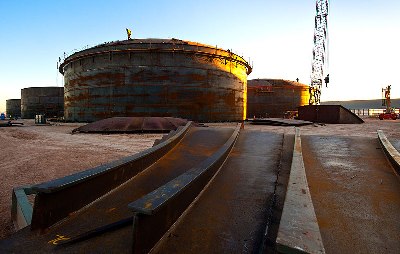Presented with funds from the U.S. Department of Energy, the University of Arizona College of Engineering researchers will lead a 5-year research project worth $5.5 M, for developing efficient and cost-effective concentrated solar power systems.

The tanks that hold the molten salts at Abengoa's Solana Plant are enormous. The salts can keep the solar-heated fluids very hot for several hours, so they can be transferred to turbines to produce electricity even when the sun isn't shining.
Energy expert Peiwen "Perry" Li will lead the research team. Professor Cho Lik Chan and assistant professor Qing Hao will be the co-researchers.
With multi-disciplinary researchers from SSES, the research program will study the properties, composition, and costs of CSP heat transfer fluids based on new molten-salt, which is meant for production of electrical power efficiently and cost-effectively in addition to absorption, transfer and storage of solar energy.
Up to 15 % of the sun's energy can be converted to electricity using photovoltaic systems like solar panels. But, CSP systems working at over 1,200 ° F can lead to 45 % more conversion efficiency.
Having different conversion processes, both photovoltaic systems and CSP systems have been challenged with nocturnal drop in power generation potential.
The research focused on creating molten-salt-based CSP heat transfer fluids with low- corrosivity and- melting points, capable of being heated to about 2,400 0 F. However, power generation at night can be facilitated by insulating the circulation systems and the fluid storage tanks, which helps generation of steam due to stored heat and electric power thru the night. Nitrates (salts) that can attain 1,500 degrees are currently being used in CSP plants.
Molten salts’ properties like thermal conductivity and viscosity will be investigated by Li, Chan and Hao, and Georgia Tech scientists. The success of CSP technology relies on reduced cost and sustainability. Sustainable energy can be generated using sodium chloride (old table salt).
The logistics and economics of large-scale extraction and processing needed for delivering large amounts of sustainable minerals for CSP plants will be studied by Moe Momayez.
Along with Professor Pierre Lucas and assistant professor Krishna Muralidharan, Deymier will perform screening of different compositions of salts followed by determination of its chemical composition and behavior, and regulation of various salt mixtures.
To mitigate the corrosive effect of superheated molten salt, Don Gervasio and ASU Poly engineers will resolve the corrosiveness of the various salts studied by the project team.
Newly generated concentrated solar power serves as sustainable technology. The 5 MW Sierra Sun Tower constructed by eSolar stands in California, U.S. The 11 MW Plantar Solar 10 near Spain is the world's first commercial solar tower power plant.
Spain leads CSP, Spanish operator Abengoa expects accomplishing the 1,900-ac, 280 MW Solana Generating Station in Arizona, in 2013, which will generate power sufficient to drive 70,000 homes.
With innovative technology, the CSP plants are expected to generate 25 % of global electricity demands by 2050.
Source: http://www.engr.arizona.edu/
Disclaimer: The views expressed here are those of the author expressed in their private capacity and do not necessarily represent the views of AZoM.com Limited T/A AZoNetwork the owner and operator of this website. This disclaimer forms part of the Terms and conditions of use of this website.